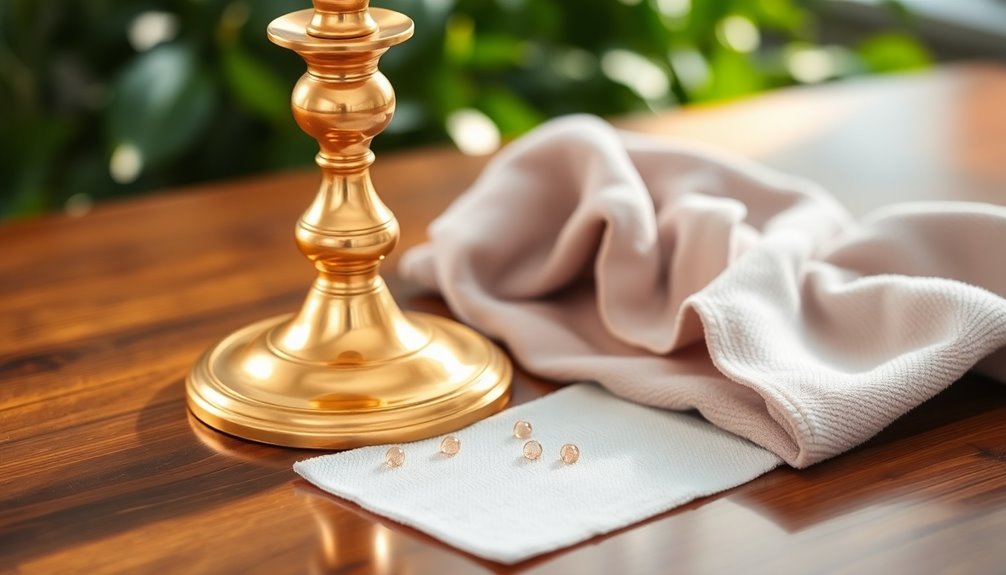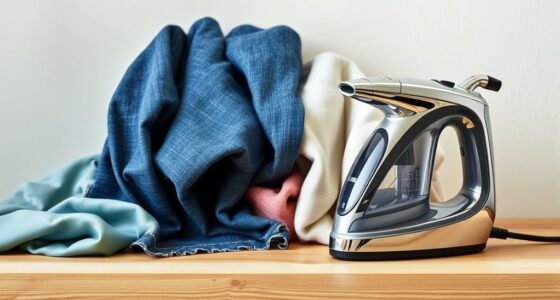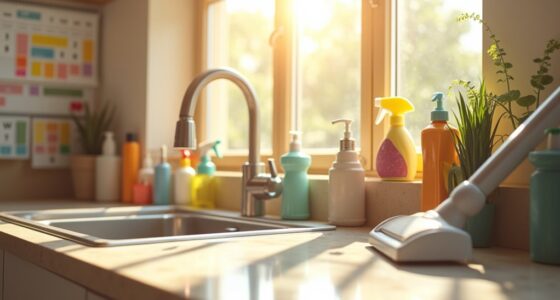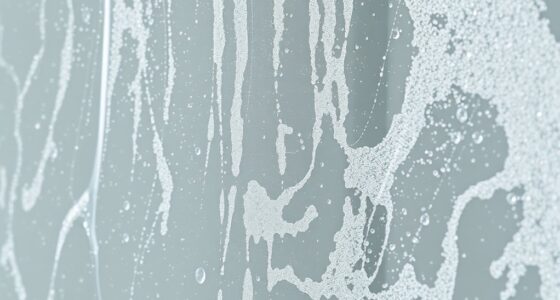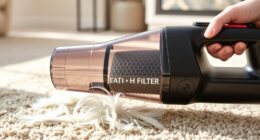To restore brass to its natural shine, start by gathering your materials, like a soft cloth and mild soap. Clean the surface with a solution of 1 tablespoon of soap mixed in a gallon of warm water. If tarnish persists, apply a paste of baking soda and vinegar, letting it sit for 30 minutes before rinsing. Polish with a brass cleaner using a lint-free cloth in a circular motion. Finally, air dry or gently pat dry your brass items. Proper storage is key to maintaining that shine. Want to discover more tips for long-lasting brilliance?
Key Takeaways
- Start by inspecting and removing loose debris with a soft brush before applying any cleaning solution.
- Use a mild soap solution or a baking soda and vinegar paste for effective tarnish removal.
- Rinse thoroughly after cleaning to prevent residue buildup and ensure a clean surface.
- Polish with a specialized brass polish, applying in small sections with a soft cloth for a high shine.
- Store cleaned brass items in a cool, dry place using soft pads or pouches to prevent scratches and tarnish.
Preparation Steps
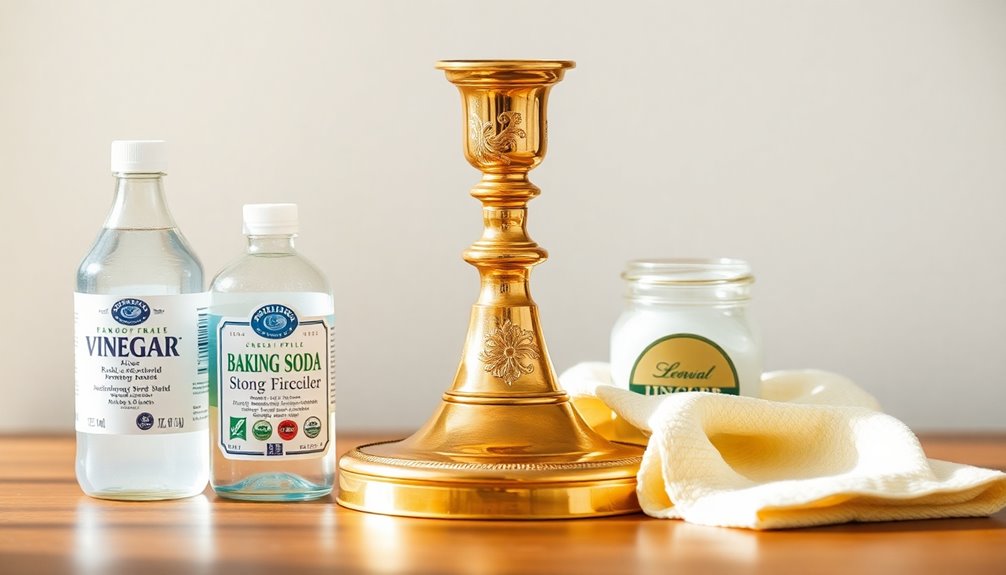
Before you dive into cleaning your brass items, it's essential to take a few preparation steps to ensure the process goes smoothly.
First, gather your materials: brass cleaner or polish, a soft cloth or sponge, warm water, and mild soap.
Next, inspect your brass item for any dirt or grime. Use a soft brush to remove loose debris and dampen the area with warm water, then scrub gently with soap.
After that, prepare your cleaning solution by reading the product label and mixing it as directed, testing a small area first.
Finally, protect your workspace by covering surfaces, removing nearby items, ensuring good ventilation, and wearing gloves.
Have a microfiber cloth ready for drying and polishing once you're done.
Effective Cleaning Methods
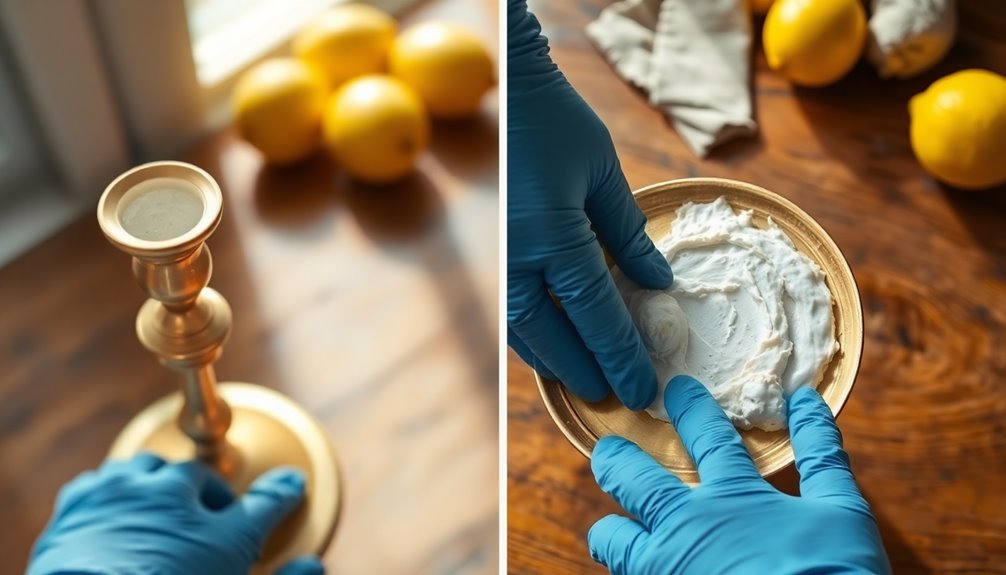
When it comes to cleaning brass, you have several effective methods at your disposal.
Start with a mild soap solution—mix 1 tablespoon of soap with 1 gallon of warm water. Apply it, let it sit for a few minutes, then rinse thoroughly and dry with a soft cloth.
If you prefer a more natural approach, create a paste using 1 tablespoon of baking soda and 2 tablespoons of vinegar. Spread it on the brass, let it sit for about 30 minutes, then rinse and dry.
Another option is to mix equal parts hydrogen peroxide and water, applying it with a cloth.
For a high-tech solution, use an ultrasonic cleaner with a mild soap solution to maintain that natural shine effortlessly.
Techniques for Removing Tarnish
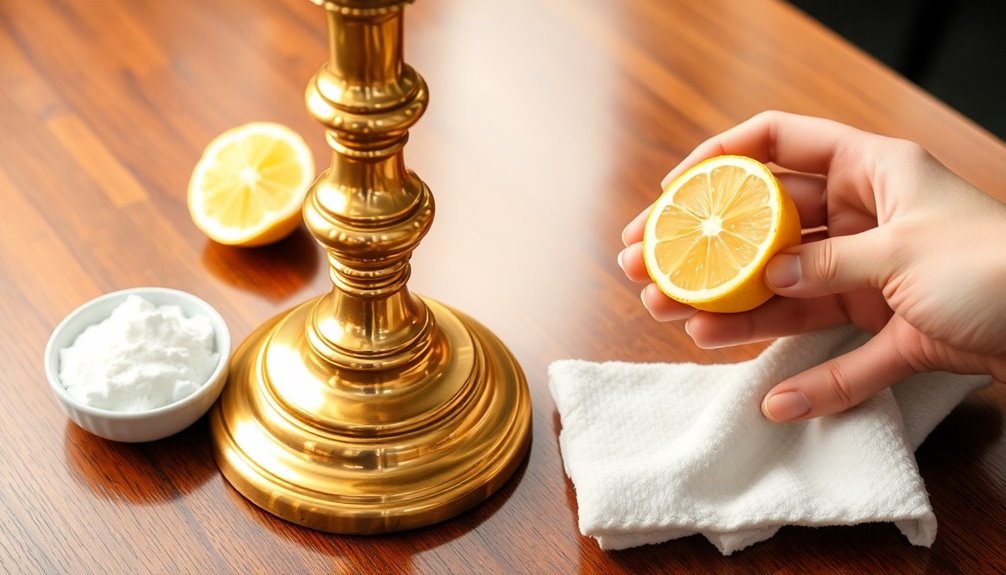
Removing tarnish from brass can be a straightforward process with the right techniques.
Start by mixing equal parts vinegar and water for a simple solution that dissolves tarnish. Alternatively, create a paste from baking soda and water to apply directly to affected areas. For tougher tarnish, hydrogen peroxide or a mixture of white vinegar and salt can work wonders.
On the physical side, use fine-grade steel wool or a soft, lint-free cloth to gently scrub away tarnish. Brass brushes and dental floss can help clean intricate details effectively.
If you prefer a more advanced method, consider using an ultrasonic cleaner with a suitable cleaning solution. Just remember to rinse thoroughly afterward to remove any residue.
Polishing Your Brass Items

Polishing your brass items can bring back their original luster and shine, enhancing their beauty and longevity.
Start by choosing the right polishing tools, like soft, lint-free cloths or polishing wheels for more aggressive work. A specialized brass polish works best, but you can also use Bar Keepers Friend or a homemade baking soda paste.
When applying the polishing compound, do it evenly, working in small sections with a circular motion. Allow the polish to sit briefly before buffing.
Use a soft cloth to buff, gradually increasing pressure, and check your progress often. For a final touch, use a microfiber cloth to achieve that high shine.
Inspect your brass and repeat if necessary for optimal results.
Proper Drying and Storage
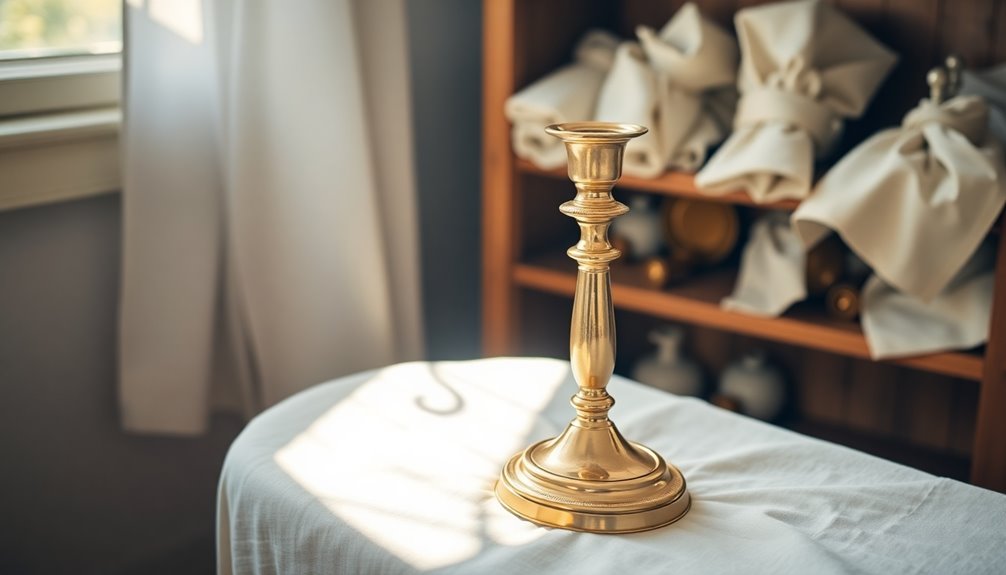
After polishing your brass items, proper drying and storage are vital to maintaining their shine and preventing tarnish.
Start by air drying your brass completely, or gently pat it dry with a microfiber cloth. Avoid direct sunlight and heat, which can cause discoloration and damage.
Store your brass on soft pads to prevent scratches, and consider using velvet pouches for smaller items. Wooden boxes lined with soft material are ideal for larger pieces.
Keep your storage area cool and dry, away from humidity and chemicals. Store items separately to avoid contact with other metals, and regularly inspect them for signs of tarnishing or damage.
Using desiccants can also help maintain a moisture-free environment.
Maintenance Tips
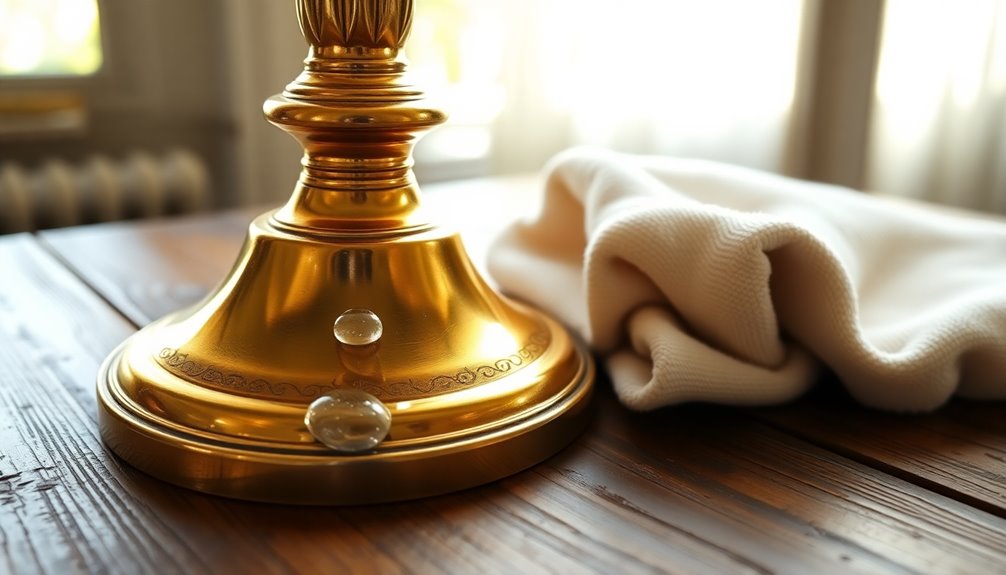
Maintaining your brass items doesn't have to be complicated; a few simple steps can keep them looking their best.
Start with daily wipes using a soft or microfiber cloth to prevent dust buildup. When cleaning, use a damp cloth—just avoid soaking your brass. Steer clear of harsh chemicals and abrasive cleaners that can damage the surface.
For polishing, specialized cloths or a product like Brasso will help restore shine. Regular buffing with a buffer can also keep tarnish at bay.
To prevent tarnish, apply a thin layer of wax and store items in a dry, cool place. Lastly, monitor humidity levels to avoid moisture buildup.
With these tips, your brass will shine brilliantly for years to come.
Important Precautions

When cleaning brass, it's crucial to take important precautions to ensure both your safety and the integrity of your items.
First, always wear protective gloves and safety goggles to shield your skin and eyes from harsh chemicals. Work in a well-ventilated area, and read all instructions carefully before use.
Avoid abrasive materials, sticking to soft cloths to prevent scratches. Steer clear of harsh chemicals like bleach or ammonia, as they can damage your brass.
Maintain a stable workspace and keep children and pets away to avoid accidents.
Finally, consider eco-friendly cleaning products and dispose of rags properly to minimize fire hazards.
Following these steps helps keep your cleaning process safe and effective.
Frequently Asked Questions
Can I Use Vinegar on Lacquered Brass Items?
You shouldn't use vinegar on lacquered brass items. Its acidic nature can damage the lacquer layer, stripping it away and exposing the brass to corrosion.
Once the lacquer's gone, your brass will likely tarnish and lose its shine. Instead, opt for a mild soap solution and a microfiber cloth to clean without risking damage.
Always test a small area first to ensure the cleaning method is safe for your specific lacquer type.
How Often Should I Clean My Brass Items?
You should clean your brass items based on how often you use them. If you use them daily, clean them daily to prevent buildup.
For items used moderately, a weekly clean works well, while monthly cleaning suffices for rarely used pieces.
Additionally, consider environmental factors like humidity and pollution, as they can affect the tarnish rate.
Always clean if you see visible dirt or before special occasions to keep them looking great.
Is It Safe to Use Lemon Juice on Brass?
Using lemon juice on brass isn't the safest option. Its high acidity can corrode the surface, leading to damage and unsightly stains.
While it might provide a temporary shine, the risks of etching and material degradation outweigh the benefits.
If you decide to try it, always dilute the juice with water and test it on a small area first.
Consider safer alternatives like mild soap or specialized brass cleaners for better results.
What Causes Brass to Tarnish Quickly?
Brass tarnishes quickly due to several factors.
High humidity and extreme temperatures can speed up oxidation, while pollutants and moisture in the air promote tarnish formation.
Handling brass frequently transfers oils from your skin, which also contributes.
Additionally, contact with acidic substances, salt, or chlorine accelerates corrosion.
If your brass has a higher copper content or poor surface finish, it's even more susceptible to tarnishing.
Proper care can help minimize these effects.
Can I Restore Old Brass Without Chemicals?
You might feel overwhelmed by the tarnished brass, but restoring it without chemicals is entirely possible.
Grab some baking soda and water to create a paste, or use vinegar and salt for a simple soak.
Lemon juice can brighten it up too, followed by olive oil for shine.
With these natural methods, you'll unveil the beauty of your brass, turning frustration into satisfaction as you watch it gleam once again.
Conclusion
In the end, keeping your brass shining bright is a labor of love that pays off big time. By preparing properly and using the right cleaning methods, you can restore that natural luster. Don't forget to polish and store your items correctly to maintain their beauty. With a little care and attention, you'll have brass that's the envy of all. So, roll up your sleeves and get started—your brass deserves the best!
